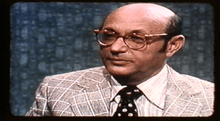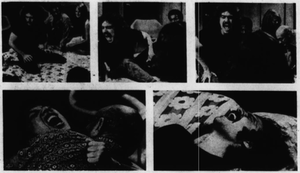Daniel Harold Casriel
Daniel Harold Casriel (March 1, 1924 – June 7, 1983) was an American psychiatrist, psychoanalyst and writer from New York City.[1] Dan Casriel's method of group psychotherapy is continued today. His novel road map to happiness evolved into a framework for the field of relationship education as the PAIRS' relationship roadmap for couples.[2] Dr. Casriel also founded the Daytop treatment centers.
Daniel Harold Casriel | |
|---|---|
 Dan Casriel talking about his 1972 book A Scream Away From Happiness | |
| Born | March 1, 1924 |
| Died | June 7, 1983 (aged 59) |
| Occupation | Psychiatrist, psychoanalyst, writer |
Early life and education
Daniel Harold Casriel was born in New York City on 1 March 1924.[1] He graduated from the University of Cincinnati College of Medicine in 1949 at age twenty-five. In 1950, he began his residency at the Kingsbridge Veterans' Administration Hospital in the Bronx. Eight months into his residency he was drafted by the military and sent to Okinawa where he served as an Army psychiatrist for a year and a half.[3]
Career
Professional training
Casriel was a trainee at the Columbia Psychoanalytic Institute for Training and Research between 1949 and 1953 and spent 7½ years in analysis Dr. Abram Kardiner,[4] the founder of the first psychoanalytic institute in the United States and a former analysand of Sigmund Freud. Casriel was also a past president of the American Society of Psychoanalytic Physicians.
Private practice
In the winter of 1953 Casriel began private practice as a psychiatrist in New York City. Shortly thereafter he was appointed as a psychiatric consultant to the Metropolitan Hospital in East Harlem and the Court of Special Sessions in Manhattan where he became active in the treatment drug addicts.
Writer
In July 1962 Casriel visited the famous Synanon therapeutic community on the US West Coast. So impressed with what he saw there, he moved into the community for a "closer look" and wrote a book about the experience (So Fair a House: The Story of Synanon). In February 1963, Casriel gave $2000 to seven members of Synanon to start a community on the East Coast. The result was a house on Greens Farm Road, Westport, Connecticut directed by Jack Hurst, former president of Synanon in Santa Monica.[5]
Consultancy
In the summer of the same year, Casriel became the psychiatric consultant for the Daytop Lodge project on Staten Island, a kind of half-way house for the rehabilitation of convicted felons who were addicts. Later, he became cofounder, psychiatric director and medical superintendent of Daytop Village, now one of the world's largest therapeutic communities.[6][7]

Experiments
In the fall of 1963, Casriel, now age 39, began experimenting with group therapy in his private practice in New York. He began leading groups alone and with peer group leaders like David A. Deitch, the Synanon director at Westport.[8] In 1972 he released his findings to the public in a book titled "A Scream Away From Happiness" where he describes The New Identity Process, a group psychotherapy that uses screaming, hugging and affirmations of basic needs.
Methods
By the late 1960s, Dr Casriel had extended his private practice to include a small therapeutic community on the top four floors of his office building. This program he called AREBA, short for Accelerated Re-education of The Emotions, Behavior and Attitudes. It consisted of about a dozen beds for young addicts who came to live, "work" and participate in the "New Identity Process". When Casriel died in 1983, former patient Steven Yohay expanded the program and became president of AREBA Casriel, Inc., today the oldest surviving private addiction treatment centre in the United States.
In the late 1970s, Casriel began teaching his method in several European centers. The German psychiatrist Dr. Walther H. Lechler became one of his students and later employed the ideas extensively in the development of the Herrenalb Model[9] of psychotherapy used at the hospital of the same name in South Germany. Another trainee was the Danish psychoanalyst, Osho sanyassin and mystic, Shanti Kristian Dahl-Madsen.[10] He incorporated the new identity process into a life-affirmative approach to spirituality he called 'Spiritual Hedonism',
Casriel's method of group psychotherapy is continued today through the efforts of the International Society of Bonding Psychotherapy which has members in 8 European cities as well as North and South America.
Influence
Casriel's novel concept of a "Relationship Road Map" became the foundation of PAIRS' approach to relationship education. Expanding on Horace Mann's focus on the pursuit of happiness as a universal human desire, Casriel theorized that the emotion of love comes from the anticipation of pleasure.[11]
Based on Casriel's theory, "bonding," which he defined as "the unique combination of emotional openness and physical closeness with another human being," is central to sustaining healthy, intimate relationships. Casriel taught that symptoms of bonding deprivation include: "illness, fatigue, depression, rigidity, constriction, isolation, and the range of anti-social behaviors such as drug and alcohol abuse, gambling and sex addictions." Casriel considered bonding a biologically-based need similar to the need for food, water, air, and shelter, yet unique as the only biologically-based need people cannot meet for themselves.[12][13]
Death
Casriel died at his home in Manhattan on 7 June 1983 age 59 from a form of Amyotrophic Lateral Sclerosis (ALS). He is survived by his wife, the former Olivia Cohen; two sons, Seth, a film editor and producer,[14] and Lyle, a financial adviser.[15]
Books
- So Fair a House: The Story of Synanon, New York: Prentice-Hall, 1963
- Daytop: Three Addicts and Their Cure, New York: Hill & Wang, 1971
- A Scream Away from Happiness, New York: Grosset & Dunlap, 1972
References
- The New York Times; Obituary June 10, 1983, Friday Late City Final Edition, Section D, Page 19
- DeMaria, Rita (2013). Building Intimate Relationships. London: Routledge. pp. 28–31. ISBN 1135454396. Retrieved 22 August 2017.
- Psychiatry In The U.S. Army: Lessons for Community Psychiatry By Albert Julius Glass, Franklin D. Jones, p.189 http://www.dtic.mil/cgi-bin/GetTRDoc?AD=ADA434841
- "Abram Kardiner: Definition from". Answers.com. 1981-07-20. Retrieved 2012-01-01.
- "Synanon Work Extolled by Mag". Sunday Herald. 77 (40). Bridgeport, Conn. 6 October 1963. p. 25. Retrieved 23 May 2020 – via News.google.com.
- "The History of Daytop New York In Substance Abuse Treatment". Daytop.org. Archived from the original on 2015-12-22. Retrieved 2012-01-01.
- November 21, 1968, Vol. XIV, No. 6 Schism on 14th Street: The Daytop Explosion by Joe Pilati. http://blogs.villagevoice.com/runninscared/archives/2010/06/drug_rehab_in_t.php Archived 2013-02-05 at Archive.today
- "David Deitch, Ph.D". Psychiatry.ucsd.edu. Archived from the original on 2012-02-29. Retrieved 2012-01-01.
- "Celenus Kliniken - Gesundheit als Aufgabe". Klinik-bad-herrenalb.com. 2011-12-28. Retrieved 2012-01-01.
- "uniomystica.se/index.html". Uniomystica.se. Archived from the original on 2013-04-18. Retrieved 2012-01-01.
- DeMaria, Rita (2002). Building Intimate Relationships. New York: Routledge. ISBN 978-1583910764.
- Eisenberg, Seth; PAIRS Foundation (2007). PAIRS Essentials. Florida: PAIRS Foundation. p. 72. ISBN 0985427817.
- Casriel, Daniel. "Quest for Emotional Health". www.danielcasriel.com. Purpose Built Families Foundation. Retrieved 21 August 2017.
- https://www.imdb.com/name/nm0143885/
- https://financialservicesinc.ubs.com/fa/lylecasriel/%5B%5D